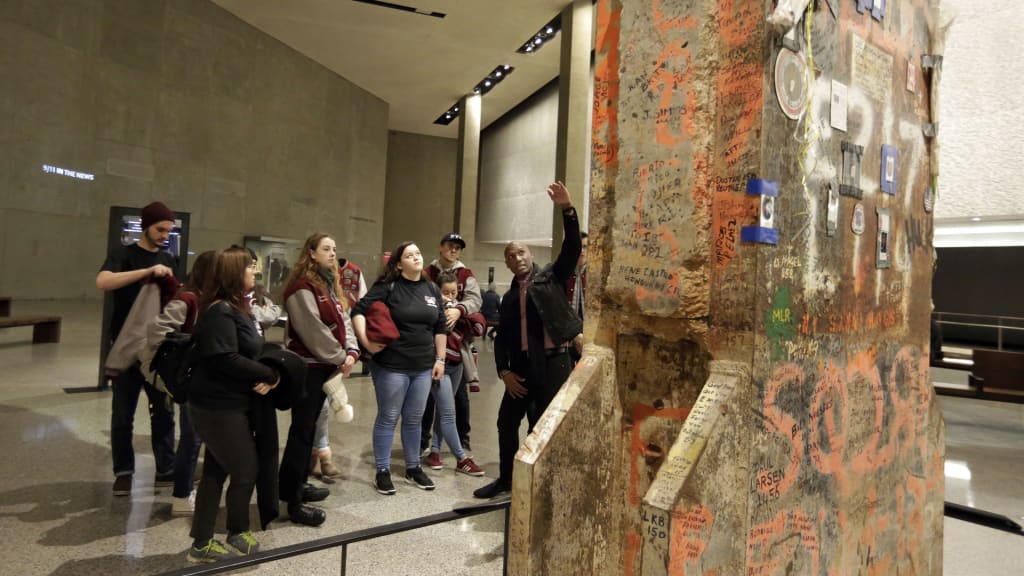
NEW YORK -- In the days and weeks following the tragic Sept. 11, 2001, attack on the World Trade Center and the Pentagon, the nation turned to a familiar, comforting friend to help them through the long days and nights.
Baseball.
Sports played a key role in the healing of New York and the rest of the United States, providing a welcome distraction for some and reminding others of the bonds the games had created between many of the victims and their loved ones.
The National September 11 Memorial & Museum is paying homage to sports' role in the aftermath of the attacks with a special exhibition, "Comeback Season: Sports After 9/11." The exhibition opens Wednesday, and it will be open through the summer of 2019.
"It was at the apex of the city healing, but also the country," said Michael Frazier, the museum's executive VP and deputy director for external affairs. "There was a 'Prayer for America' service at Yankee Stadium on Sept. 23, 2001, in which 20,000 people came to the Bronx. Then even though they fell short, the Yankees gave the city something to cheer about with their run to the World Series."
In the immediate aftermath of the World Trade Center attack, the Mets and Yankees played integral roles in the city's healing process. The Mets, led by then-manager Bobby Valentine, helped load trucks with supplies as Shea Stadium's parking lot was transformed into a staging area. Joe Torre's Yanks visited a number of hospitals and the Armory, trying to comfort families as they waited for word on the status of loved ones.
Ten days after the attack, Mike Piazza's dramatic home run off Atlanta's Steve Karsay -- a New York City native himself -- provided the first opportunity for fans to let loose, causing an eruption of emotion in the ballpark and on televisions around the city.
"We were lucky to have the game; lucky to have the players," Frazier said. "We were lucky to have those iconic moments like Piazza's home run and the Yankees' postseason. To have those moments after something like that had happened, to have baseball, that helped make sense of a lot of things for us, I believe."
Commissioner Emeritus Bud Selig is among the honorary exhibition chairs, along with former NFL Commissioner Paul Tagliabue, former NBA Commissioner David Stern and NHL Commissioner Gary Bettman, among others.
Among the signature moments that are featured in the exhibition are Piazza's go-ahead home run for the Mets at Shea Stadium in the team's first game following the attacks and President George W. Bush's ceremonial first pitch prior to Game 3 of the World Series at Yankee Stadium, two of the most iconic New York moments associated with the aftermath of the tragedy.
"We recognize the importance of sports and how it brings so many people together," Frazier said. "It was important, not only because of the timing of the attack, but the sport itself and the way Americans gravitate to it. Everyone knows baseball. It's befitting that baseball is helping tell the story, because there are so many great stories in the sport itself. A lot of people can relate to it."
Among the other baseball-related features in the exhibit are the friendship between Derek Jeter and the daughter of a pilot on one of the hijacked planes; players visiting Ground Zero, signed memorabilia from Piazza, Torre and others; tickets from postponed games; marquees from various stadiums and signs from fans in other cities paying homage to New York City. Some of the items on display are on loan to the museum by the National Baseball Hall of Fame.
"Baseball was touching everything," Frazier said. "It's a cliché, but it's America's pastime, so people could take solace in the sport. They would go to the ballgame, they would eat popcorn and just lose themselves in the game. For some people, after such a tragic event had happened, they needed that familiar setting."
For more information on the exhibition, visit www.911memorial.org/ComebackSeason.